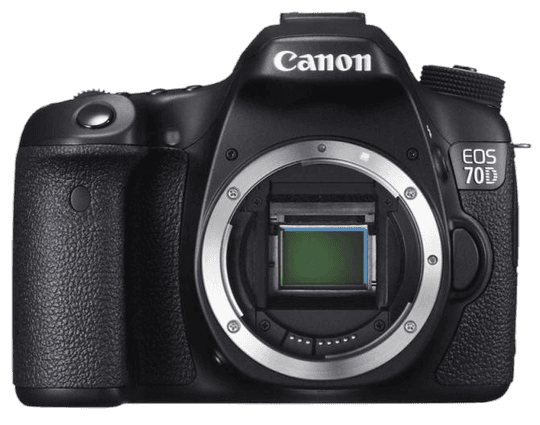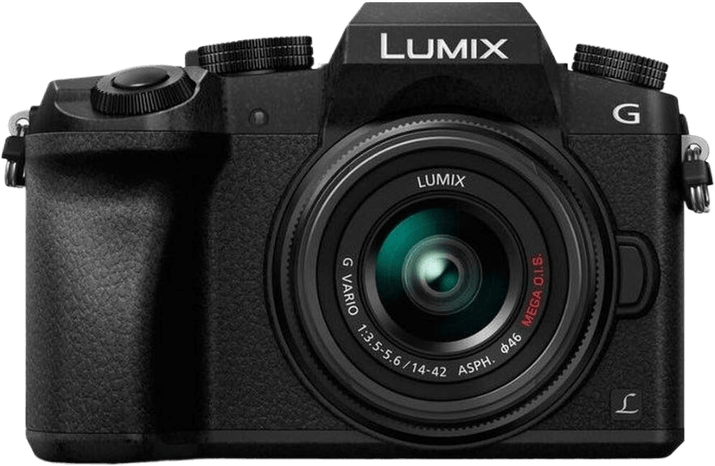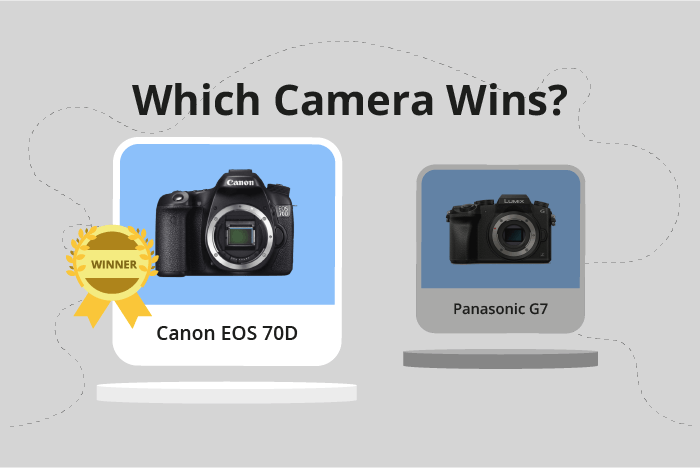Canon EOS 70D vs Panasonic Lumix DMC-G7 Comparison
Canon EOS 70D

Panasonic Lumix DMC-G7

The Canon EOS 70D comes out on top with a score of 60/100, while the Panasonic Lumix DMC-G7 scores 52/100. Both cameras share similarities, such as being released in the 2010s and having a launch price above $700. The Canon EOS 70D, a DSLR, is superior due to its higher score and larger size (139 x 104 x 79mm), which can contribute to better handling. Weighing 755g, it may provide a more solid feel.
On the other hand, the Panasonic Lumix DMC-G7, a mirrorless camera, is more compact (125 x 86 x 77mm) and lightweight (410g), making it more convenient for travel. Despite the lower score, its lower launch price of $799 may appeal to budget-conscious consumers.
Taking these factors into account, the Canon EOS 70D is the winner, but the Panasonic Lumix DMC-G7 has its advantages for certain users.
Canon EOS 70D vs Panasonic Lumix DMC-G7 Overview and Optics
The Canon EOS 70D outperforms the Panasonic Lumix DMC-G7 in optics with a score of 58/100, compared to the G7’s 51/100. Both cameras share common specifications, including a CMOS sensor, a shooting speed of 7 frames per second, and an absence of image stabilization. However, the EOS 70D possesses features that give it an edge over the G7.
The EOS 70D has a higher megapixel count at 20.2, compared to the G7’s 16 megapixels, resulting in more detailed and sharper images. Additionally, the EOS 70D has a larger APS-C sensor size, as opposed to the G7’s Micro Four Thirds sensor. This difference in sensor size allows the EOS 70D to capture more light, providing better low-light performance and increased dynamic range. The Canon EF-S lens mount on the EOS 70D also offers a wider variety of lenses to choose from, increasing its versatility.
On the other hand, the Lumix G7 boasts a higher DXOMARK sensor score of 75, compared to the EOS 70D’s 68. This indicates that the G7’s sensor performs better in terms of color depth, dynamic range, and low-light performance. The G7 also features a Micro 4/3 lens mount, which supports a range of compact lenses, making the camera more portable and convenient for travel.
Taking these factors into account, the Canon EOS 70D emerges as the winner in optics, offering a superior megapixel count, larger sensor size, and a more extensive lens selection. Meanwhile, the Panasonic Lumix DMC-G7’s advantages lie in its sensor performance and more compact lens options.
Canon EOS 70D vs Panasonic Lumix DMC-G7 Video Performance
The Panasonic Lumix DMC-G7 outperforms the Canon EOS 70D in video capabilities with a score of 83/100, compared to the 70D’s 43/100. Both cameras share some video specifications, such as offering Full HD resolution and a maximum video dimension of 1920 x 1080. However, the G7 surpasses the 70D in various aspects, making it the superior choice for video recording.
The G7’s most significant advantage is its 4K video resolution, which provides four times the detail of Full HD. This feature allows users to capture more intricate and visually stunning footage. Additionally, the G7 has a maximum video frame rate of 60fps, double the 70D’s 30fps. This higher frame rate results in smoother video playback and enhanced slow-motion capabilities.
Another notable feature of the G7 is its built-in time-lapse functionality, which the 70D lacks. Time-lapse photography allows users to capture and condense lengthy events into short, visually engaging videos. This feature expands the G7’s creative possibilities and grants users more flexibility in their video projects.
While the Canon EOS 70D falls short in comparison to the G7, it still offers reliable Full HD video recording, making it a suitable option for casual videographers or those who do not require advanced video features.
The Panasonic Lumix DMC-G7’s superior video capabilities, including 4K resolution, 60fps frame rate, and built-in time-lapse functionality, make it the clear winner in this comparison. The Canon EOS 70D, while providing decent Full HD video recording, cannot compete with the G7’s advanced features and versatility.
Canon EOS 70D vs Panasonic Lumix DMC-G7 Features and Benefits
The Canon EOS 70D outperforms the Panasonic Lumix DMC-G7 in features with a score of 70 out of 100, compared to the G7’s 58. Both cameras share several specifications, such as 3-inch screen size, touchscreen, flip screen, lack of GPS, WIFI connectivity, and absence of Bluetooth.
The 70D’s feature superiority stems from its screen resolution, which is 1,040,000 dots, offering sharper and clearer images on the screen. This higher resolution provides a better user experience when reviewing images, navigating menus, or composing shots. In addition, the Canon EOS 70D’s higher score suggests it has more features that are not listed here, making it a more versatile camera.
On the other hand, the Panasonic Lumix DMC-G7 boasts a higher screen resolution of 2,360,000 dots, providing even better image quality on the screen. This advantage could be beneficial for photographers who prioritize image review and composition on the camera’s screen. However, this higher resolution does not translate to a higher overall feature score for the G7.
In comparing the Canon EOS 70D and Panasonic Lumix DMC-G7, the 70D has a clear edge in features with a score of 70, while the G7 trails behind at 58. The 70D’s advantages lie in its higher screen resolution and potentially more features not mentioned here. The G7’s higher screen resolution may be appealing to some photographers, but it does not compensate for its lower overall feature score. Therefore, the Canon EOS 70D is the better camera in terms of features.
Canon EOS 70D vs Panasonic Lumix DMC-G7 Storage and Battery
The Canon EOS 70D triumphs in storage and battery with a score of 37, while the Panasonic Lumix DMC-G7 trails closely behind at 35. Both cameras share similarities in storage, with one memory card slot each and compatibility with SD, SDHC, and SDXC memory cards.
The 70D outperforms the G7 in battery life, offering 920 shots compared to the G7’s 350 shots. This significant difference is due to the 70D’s LP-E6 battery type. However, the G7 has an advantage with its USB charging feature, which the 70D lacks. This makes the G7 more convenient for on-the-go charging and travel.
Despite the G7’s USB charging advantage, the Canon EOS 70D’s superior battery life makes it the better choice for photographers who prioritize longevity in their camera’s battery performance.
Canon EOS 70D vs Panasonic Lumix DMC-G7 – Our Verdict
Are you still undecided about which camera is right for you? Have a look at these popular comparisons that feature the Canon EOS 70D or the Panasonic Lumix DMC-G7:

